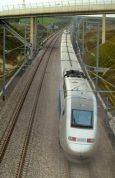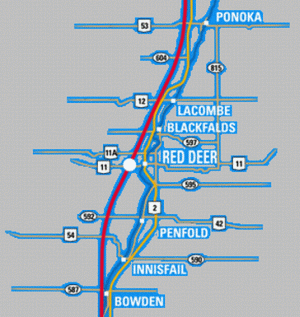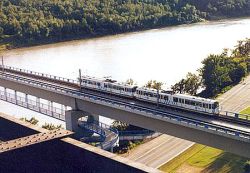| |

Home
Rails and
Trails
Historic
Trails
Rail History of
Central
Alberta
Rail
Heritage
Preservation
High Speed
Rail
Corridor
for Alberta
The Trans
Canada
Trail in
Central Alberta
Innovative
Transport
High Speed
Rail
Corridor
for
Alberta
The Trans
Canada
Trail in
Central Alberta
Sustainable
Community
Heritage
Regional
Rail History
Red Deer
and Area
Personal
Profile
Contact Me
Links
Site Map







|
High Speed Rail
The Vision
for Inter-Urban
Rapid Passenger Transportation Corridors in Alberta
 The time has come to establish efficient, sustainable and
rapid passenger rail corridors in Alberta, initially between Calgary,
Red Deer and Edmonton, and ultimately linking all the major cities in
the province, creating a single dynamic economic region. Those corridors
could include high speed rail, LRT, commuter rail, other forms of rapid
passenger transportation or any combination thereof. The time has come to establish efficient, sustainable and
rapid passenger rail corridors in Alberta, initially between Calgary,
Red Deer and Edmonton, and ultimately linking all the major cities in
the province, creating a single dynamic economic region. Those corridors
could include high speed rail, LRT, commuter rail, other forms of rapid
passenger transportation or any combination thereof.
The critical factors for such a system to meet its potential are that they integrate well and are served by good
feeder systems to and from other municipalities and people generators
such as tourist attractions, high density housing, commercial power centres and major industrial complexes.
The provincial government has a rare opportunity to initiate a
world-class integrated system at a time of economic prosperity, rapid
population growth, as-yet undeveloped and relatively inexpensive land
close to urban centres and an increasing public appetite to move quickly
from one urban centre to another with the least impact on the
environment.
 Due to increasing capacity and safety pressures on our highways, the
increasing public desire for alternative transportation, environmental
and health issues and the ever-increasing cost of building, expanding
and maintaining the highway network, the province needs to be visionary
in developing an efficient, cost-effective, environmentally-friendly
transportation system that concentrates on moving people quickly between
the economic urban travel generators throughout the province. Due to increasing capacity and safety pressures on our highways, the
increasing public desire for alternative transportation, environmental
and health issues and the ever-increasing cost of building, expanding
and maintaining the highway network, the province needs to be visionary
in developing an efficient, cost-effective, environmentally-friendly
transportation system that concentrates on moving people quickly between
the economic urban travel generators throughout the province.
 The first step in creating this vision is to secure a series of
city-to-city rail rights-of-way before the cost of purchasing the land
becomes cost-prohibitive due to the continued expansion of land
development. The ultimate vision would be a provincial rapid passenger
rail spine linking the larger urban centres in the south of the province
to the urban growth areas in the north. Regional transportation feeder
systems would compliment and complete the overall vision. The first step in creating this vision is to secure a series of
city-to-city rail rights-of-way before the cost of purchasing the land
becomes cost-prohibitive due to the continued expansion of land
development. The ultimate vision would be a provincial rapid passenger
rail spine linking the larger urban centres in the south of the province
to the urban growth areas in the north. Regional transportation feeder
systems would compliment and complete the overall vision.
 The most viable means of putting such a system in place starts with the
province securing land for rights-of-way. Knowing the location of
rights-of-way provides for better municipal and inter-municipal planning
of long term development and growth. The most viable means of putting such a system in place starts with the
province securing land for rights-of-way. Knowing the location of
rights-of-way provides for better municipal and inter-municipal planning
of long term development and growth.
The second part is to form a P3 partnership with the private sector to
provide the infrastructure, supply the train-sets, operate and maintain
the system.
 The benefits of acting now include: The benefits of acting now include:
- Inflation and continued development will escalate the cost of
acquiring land later;
- Inflation will escalate the cost of constructing the system later;
- The population continues to increase at a rate that will only make the
concept of a rapid interurban passenger transportation system
increasingly viable and desirable, especially in the Calgary-Red
Deer-Edmonton corridor -- most studies indicate that such a system is
viable now;
-Delaying or eliminating the need for costly highway expansion and
infrastructure;
-Provides an opportunity for Alberta to construct a world-class
transportation system that would integrate the province into a single
economic global entity;
-The reduction of pollution and highway collisions would reduce
escalating health care costs;
 - An electrified rail system is the most energy-efficient means of
moving large numbers of people between cities and would therefore reduce
greenhouse gas emissions and fossil fuel consumption significantly; - An electrified rail system is the most energy-efficient means of
moving large numbers of people between cities and would therefore reduce
greenhouse gas emissions and fossil fuel consumption significantly;
- A dedicated rail system would be a safer and more reliable
transportation system in all weather as compared to other modes of
transportation;
- Once built, a rapid rail system would have sufficient capacity to
eliminate the need to expand the infrastructure well into the future;
 - Passengers would be far more productive than if they were sitting in
their vehicles in traffic and would reach their destinations 50% or more
faster; - Passengers would be far more productive than if they were sitting in
their vehicles in traffic and would reach their destinations 50% or more
faster;
- The economic spinoffs of attracting business, industry and tourism
would be significant;
- The opportunity exists to share funding between various levels of
government and the private sector;
 - A rapid passenger transportation corridor could also act as a utility
corridor for future water, power, telecommunications and other utility
systems that would generate additional income from the corridor's use; - A rapid passenger transportation corridor could also act as a utility
corridor for future water, power, telecommunications and other utility
systems that would generate additional income from the corridor's use;
- Rapid interurban passenger rail service is likely to have as
significant an impact on the prosperity and mobility of the province as
the building of the divided Highway 2 corridor in the 1960's and the
building of the Canadian Pacific Railway in the 1880's.
One of the proposals on the table comes from Alberta High Speed Rail
Inc., a company that envisions a downtown Calgary to downtown Edmonton
dedicated double-track line with a stop west of Red Deer in 84 minutes
using 300 km/hr trainsets. The route is proposed to be the 'Greenfield
Route' west of the Highway 2 corridor introduced in the 1980s that would
almost be a straight line between the two major cities. At each end of
the route, the proposal suggests sharing rights-of-way with Canadian
Pacific but separate track. The original proposal suggested a Red Deer
terminal near Highway 11.
Modifications of the route will likely be necessary. One modification
suggests that the Red Deer terminal be combined with a new Red Deer
Regional Airport terminal proposed for the northwest corner of the
airport property near McKenzie Road and the C & E Trail. Other proposals
suggest that the line integrate with the LRT plans for Calgary and
Edmonton although the province has already purchased property in the
downtowns of each city for a terminal.
The Van Horne Institute determined in 2004 that such a system is now
viable providing that the initial infrastructure is built by the
province in much the same way as the province provides the
infrastructure for the highway system. The study looked at a number of
options including the Greenfield route which would provide for the
fastest trains and the least conflict with existing uses.
 The
use of the existing Canadian Pacific north-south right-of-way is also
potentially viable but creates a number of challenges. Trains could
still be relatively high speed but significantly slower than the
Greenfield route. The CP option also creates potential safety and
scheduling conflicts with freight movements, challenges with going
through several towns and the necessity of major infrastructure
improvements including straightening out curves, closing at-grade
crossings and building a series of grade separations. The
use of the existing Canadian Pacific north-south right-of-way is also
potentially viable but creates a number of challenges. Trains could
still be relatively high speed but significantly slower than the
Greenfield route. The CP option also creates potential safety and
scheduling conflicts with freight movements, challenges with going
through several towns and the necessity of major infrastructure
improvements including straightening out curves, closing at-grade
crossings and building a series of grade separations.
Another option is the existing Highway 2 right-of-way but the costs of
adapting every interchange could be almost as high as a new dedicated
route.
The costs of providing the infrastructure is huge but not unprecedented.
Building the 4-lane divided Highway 2 expressway in the 1950s was very
costly at the time but cheap by today's standards. And at the time,
there didn't appear to be the traffic to justify it. The Alberta
government has also invested billions of dollars in airports, the
highway network including the ring roads for Calgary and Edmonton, LRT,
oil sands, the petrochemical industry, the SuperNet, power generation
and many other projects.
 As
a first step towards a world-class rapid inter-urban passenger
transportation system, provincial
investment in acquiring land for such a system will ultimately create a healthier, more
environmentally-friendly, more productive, more efficient and stronger
future for the citizens of Alberta. As
a first step towards a world-class rapid inter-urban passenger
transportation system, provincial
investment in acquiring land for such a system will ultimately create a healthier, more
environmentally-friendly, more productive, more efficient and stronger
future for the citizens of Alberta.

|
|
|